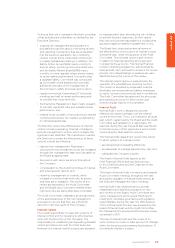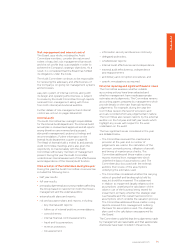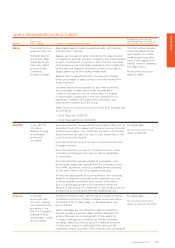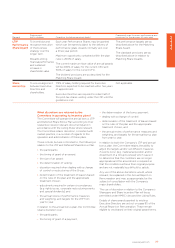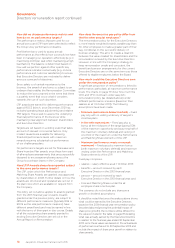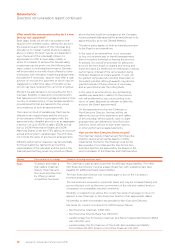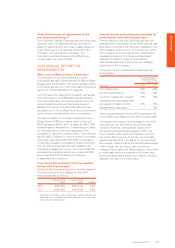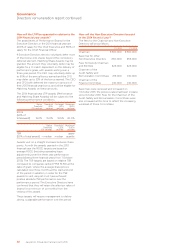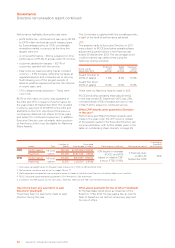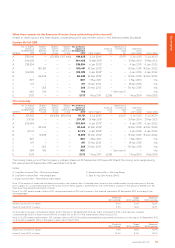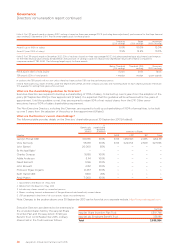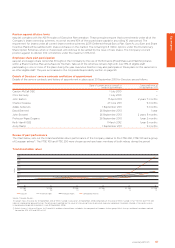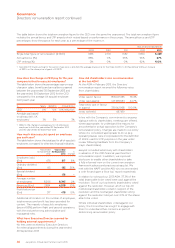EasyJet 2013 Annual Report Download - page 80
Download and view the complete annual report
Please find page 80 of the 2013 EasyJet annual report below. You can navigate through the pages in the report by either clicking on the pages listed below, or by using the keyword search tool below to find specific information within the annual report.easyJet plc Annual report and accounts 2013
78
How did we choose performance metrics and
how do we set performance targets?
The performance metrics that are used for our
annual bonus and LTIP have been selected to reflect
the Group’s key performance indicators.
Profit before tax is used to assess annual
performance as this reflects how successful we have
been in managing our operations effectively (e.g. in
maximising profit per seat whilst maintaining a high
load factor). The balance is determined based on
how well we perform against other specific key
performance indicators set annually (e.g. on-time
performance and customer satisfaction) to ensure
that Executive Directors are motivated to deliver
across a scorecard of objectives.
Since safety is of central importance to the
business, the award of any bonus is subject to an
underpin that enables the Remuneration Committee
to reduce the bonus earned in the event that there
is a safety event that occurs that it considers
warrants the use of such discretion.
LTIP awards are earned for delivering performance
against ROCE (which, since December 2012 has
included operating lease adjustments) and relative
TSR targets. These seek to assess the underlying
financial performance of the business while
maintaining clear alignment between shareholders
and Executive Directors.
Targets are set based on a sliding scale that takes
account of relevant commercial factors. Only
modest rewards are available for delivering
threshold performance levels with maximum
rewards requiring substantial out-performance
of our challenging plans.
No performance targets are set for Sharesave and
Share Incentive Plan awards since these form part
of all-employee arrangements that are purposefully
designed to encourage employees across the
Group to purchase shares in the Company.
Have LTIP Awards always been granted subject
to the same performance targets?
The LTIP, under which the Performance and
Matching Share Awards are granted, was approved
by shareholders in 2008. Further details on how the
awards are structured and operated are set out in
the plan rules which are available on request from
the Company.
The policy set out above applies to awards granted
from the 2013 financial year onwards. Awards
granted under the previous policy, are subject to
different performance measures (typically ROE or
ROCE as the sole performance measure), have
different award levels and may be earned in line
with the terms of their grant in due course. Details
of all the outstanding share awards granted to
existing Executive Directors are set out in the
Annual Report on Remuneration.
How does the executive pay policy differ from
that for other easyJet employees?
The remuneration policy for the Executive Directors
is more heavily weighted towards variable pay than
for other employees to make a greater part of their
pay conditional on the successful delivery of
business strategy. This aims to create a clear link
between the value created for shareholders and the
remuneration received by the Executive Directors.
However, in line with the Company’s strategy to
keep remuneration simple and consistent, the
benefit and pension arrangements for the current
Executive Directors are on the same terms as those
offered to eligible employees below the Board.
How much could the Executive Directors earn
under the remuneration policy?
A significant proportion of remuneration is linked to
performance, particularly at maximum performance
levels. The charts on page 79 show how much the
CEO and CFO could earn under easyJet’s
remuneration policy (as detailed above) under
different performance scenarios (based on their
salaries as at 1 October 2013). The following
assumptions have been made:
• Minimum (performance below threshold) – Fixed
pay only with no vesting under any of easyJet’s
incentive plans.
• In line with expectations – Fixed pay plus a
bonus at the mid-point of the range (giving 50%
of the maximum opportunity and assuming half of
the maximum voluntary deferral) and vesting of
one third of the maximum under the Performance
and Matching Share elements of the LTIP.
• Maximum (performance meets or exceeds
maximum) – Fixed pay plus maximum bonus
(with maximum voluntary deferral) and maximum
vesting under the Performance and Matching
Shares elements of the LTIP.
Fixed pay comprises:
• salaries – salary effective as at 1 October 2013;
• benefits – amount received by each
Executive Director in the 2013 financial year;
• pension – amount received by each
Executive Director in the 2013 financial year; and
• Free and Matching Shares under the all
employee share incentive plan.
The scenarios do not include any share price
growth or dividend assumptions.
It should be noted that since the analysis above shows
what could be earned by the Executive Directors
based on the 2014 financial year remuneration policy
described above (ignoring the potential impact of
share price growth), the numbers will be different to
the values included in the table on page 83 detailing
what was actually earned by the Executive Directors
in relation to the financial year ended 30 September
2013, since these values are based on the actual levels
of performance achieved to 30 September 2013 and
include the impact of share price growth in relation to
share awards.
Governance
Directors’ remuneration report continued



